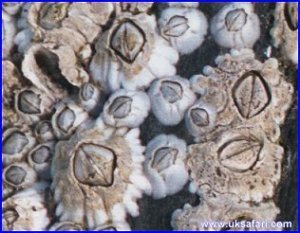They are egg cases from a juvenile thorny skate.  The skate is related to sharks and rays. Sharks, skates, and rays all have a skeleton made up of cartilage, the flexible material that is found in our noses and ears. One tiny skate will hatch from each egg after nine months – hatching under the surface of the water. Usually, what we see wrapped up in the seaweed “wrack line” is the discarded egg cases. Another nickname for these egg cases is the “mermaid’s purse.” Check out this BCS post to learn the difference between skates and rays.
The skate is related to sharks and rays. Sharks, skates, and rays all have a skeleton made up of cartilage, the flexible material that is found in our noses and ears. One tiny skate will hatch from each egg after nine months – hatching under the surface of the water. Usually, what we see wrapped up in the seaweed “wrack line” is the discarded egg cases. Another nickname for these egg cases is the “mermaid’s purse.” Check out this BCS post to learn the difference between skates and rays.
Image (c) NOAA – Alaska Fisheries Science Center.
Do you have another great question? Email info@beachchairscientist.com!











What people are saying …